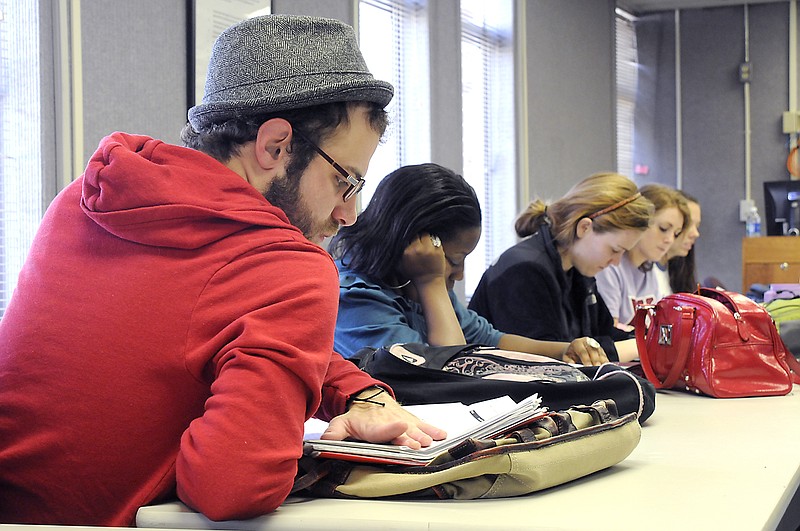Tres Wittum gets a little antsy sitting through college classes day in and day out.
It runs in the family, Mr. Wittum said. His father dropped out of college at 21 to start a career, only to return for a bachelor's degree 20 years later.
PDF: American Male Imperative
Now his dad's always harping on the importance of college.
"Pay now or pay later," Mr. Wittum said, mimicking the advice.
Still, his father's life lessons don't keep the UTC senior, who's majoring in communications, from thinking about canning school and doing what he thinks men are supposed to do -- earn money.
"I hate school. You feel like you are treading water. I am constantly looking at how can I get out of here," he said.
Colleges and universities in Tennessee and Georgia are having a hard time selling the value of a college degree to young men such as Mr. Wittum. Even with extraordinary enrollment booms at colleges driven by the recession, the gap between male and female students is staggering. At some area colleges, the split is nearly 2-to-1 in favor of females.
"You wonder: Where are the boys? What happened to them?" said Dr. Henry Codjoe, director of institutional research at Dalton State College in Dalton, Ga. "This is something that hasn't been resolved. We are still trying to figure out what we should do. Something is going on that we need to get our hands on. It's getting worse."
While state and national higher education leaders laud colleges for drawing women -- once a minority among degree holders -- into post-secondary education, many are starting to wonder if schools are leaving young men behind.
The gender gap, which has persisted for more than a decade, may keep states from reaching lofty goals for improving the number of college graduates now set by national and state policy.
"We have an under-represented population that we need to focus on," said Dr. Carl Hite, president of Cleveland State, which has a 39 percent male enrollment. "If the population is 50/50, our college population does not reflect the community breakdown. If that is true, then we have some work to do."
Some states, including Georgia, have launched initiatives to try and increase the number of black males attending college. The Association of Public and Land-grant Universities and the College Board, two national groups, recently began initiatives and research to find ways to lure as many men to colleges as women.
"If the trend in graduation for males ... continues at its current rate, the competitive knowledge base of the nation's overall workforce will be impacted," said a report called the "American Male Imperative" put together by the Association of Public and Land-grant Universities.
DEMOGRAPHIC MISMATCH
One of the biggest concerns about colleges trending toward female enrollment is that it doesn't reflect U.S. demographic data, officials said.
The U.S. Census Bureau reports that the traditional college-age population -- ages 20 to 29 -- is 50.7 percent men and 49.2 percent women. Males comprise 42.8 percent of the college population, and women make up 57.2 percent, according to the National Center for Education Statistics.
These numbers have incited some debate over whether colleges should start campaigns, scholarships and recruiting efforts targeted at males, just as they have done with women and minorities, officials said.
"It is the only way to address the gap," Dr. Codjoe said. "We need a balance."
But first, colleges and universities must understand why women are outpacing men in college attainment and grades.
Some argue that middle schools and high schools have given favorable treatment to women or that they need to teach boys differently than women. There also are arguments that societal pressures and ideas about masculinity teach boys to devalue education.
NATIONAL ENROLLMENT RATES1997Male -- 44.1 percentFemale -- 55.6 percent2002Male -- 43.4 percentFemale -- 56.6 percent2007Male -- 42.8 percentFemale -- 57.2 percentSource: Association of Public and Land Grant Universities
Having been one of only three boys in a high school honors program with 20 women, University of Tennessee at Chattanooga senior Daniel Hunley said he's always lived with the education gender gap.
Teachers treated the boys differently, but the real roadblock was peer pressure, he said.
"I think that being really intelligent in high school for a female is a plus socially," Mr. Hunley said. "There were not a lot of popular guys in the honors program, but that wasn't true for girls."
But an upper hand in high school and college is one thing, getting ahead in the work world is another, he said.
"I have always kind of heard about the big gap between men and women in the work place," he said. "When I got to college, it was all the girls that were succeeding, that are known as the really, really smart ones.
"I guess the real world is a little bit different than college."
